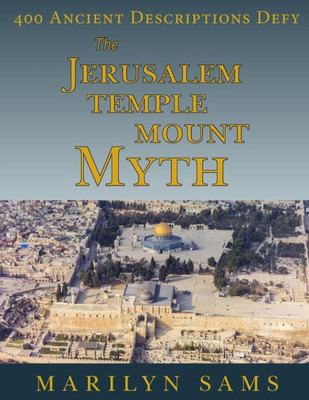

Sale
The Jerusalem Temple Mount Myth
CreateSpace Independent Publishing Platform
ISBN13:
9781719259996
$65.00
$62.81
The Jerusalem Temple Mount Myth amasses over 400 literary descriptions from several versions of the Bible, history, the Talmud, other Jewish sources, pseudepigrapha, and the Apocrypha to demonstrate the First and Second Jewish temples stood in the City of David, above the Gihon Spring. The alleged temple mount (the Haram-esh Sharif) is compared with Josephus's description of the Roman camp ("Antonia"--the actual identity of the Haram esh-Sharif), as well as his description of the temple, exposing numerous discrepancies. The archaeology of the City of David is also included, and excavations are related to the literary evidence, where possible. A list of the 400 descriptions is included at the end. Two problems for the traditional location include descriptions of a spring within the temple precincts (the Gihon Spring) and its being built within the boundaries of the City of David, which was confined to the lower half of the southeastern hill in the Israelite period prior to Hezekiah, and in the Persian and Greek periods--even in the Roman period, according to Josephus (it being like a "moon when she is horned"--the shape of the southeastern hill). Traditionalists claim the southeastern hill was extended northward to include the temple and an acropolis, but 3 Kings 2: 35 (Septuagint version) describes Solomon building the temple and his palace before breaching the wall of the City of David to install the daughter of Pharoah in her own house. There is no description of an extension north of the southeastern hill. The northern wall was still in place in the sieges of Pompey and Herod. The extension is assumed with Herod's expansion of the Baris to become Antonia. Other scriptures describe the temple within the city, such as Solomon's temple dedication enjoining the people to pray toward the city, Isaiah 29, which speak of sacrifices being offered in Ariel, the city where David dwelt, or Lamentations describing the stones at the top of all the city streets after the Babylonian destruction. The most crucial descriptions of all, however, are the extant references to Mount Zion (known to have been on the southeastern hill) as the location of the temple. Josephus described the temple hill as "descending toward the east parts of the city," while there has never been a temple on the east parts of the Haram esh-Sharif. Josephus also described the city (on the western hill) as lying "near to the temple in the manner of a theater," describing the curvature of the two hills lying in concert with each other in the lower Tyropoeon Valley, not the upper Tyropoeon Valley where the Haram stands. He also said there was a deep valley on the temple's south side, which can be identified as the confluence of the Lower Tyropoeon, Hinnom, and Kidron Valleys, with no such valley south of the Haram. Josephus also described the east wall of both Solomon's and Herod's temples as lying within the valley, while the Haram's east wall is at the top of the valley. He said that Agrippa II completed the temple, but the Haram is unfinished at its northern corner. He said the temple was built from the ground up to equal a four-furlong square, while the Haram is a 36-acre trapezoid whose northern corner is rock scarp and couldn't have been built as described. Trapezoids do not qualify as the sacred geometry required for building temples. A trapezoid, is, however, a commonplace shape for a Roman camp. The Haram also fits within the average size of a Roman camp (50 acres), while the temple complex described by Josephus was only nine acres--typical of other Roman-Greco temple complexes of the period. Josephus's descriptions of the temple's height (450 feet), its shape (square), and the length of its porticoes (600 feet), does not match with the Haram's dimensions. He also said its south wall reached just to the valley (the lower Tyropeon), while the Haram's southern wall crosses over the Tyropoeon and ends on the western hill.
- | Author: Marilyn Sams
- | Publisher: Createspace Independent Publishing Platform
- | Publication Date: May 23, 2018
- | Number of Pages: 332 pages
- | Language: English
- | Binding: Paperback
- | ISBN-10: 1719259992
- | ISBN-13: 9781719259996
- Author:
- Marilyn Sams
- Publisher:
- Createspace Independent Publishing Platform
- Publication Date:
- May 23, 2018
- Number of pages:
- 332 pages
- Language:
- English
- Binding:
- Paperback
- ISBN-10:
- 1719259992
- ISBN-13:
- 9781719259996




